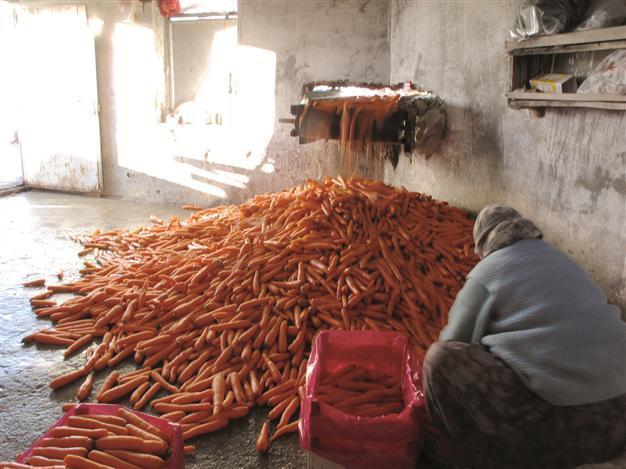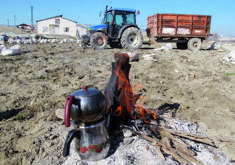Orange gold in Beypazarı
WILCO VAN HERPEN

Dozens of trucks are loaded with carrots which then find their way to the markets in other cities.
It is 7 a.m. and I am standing in the middle of a carrot field. It is cold and I am happy that I wore a thick jacket. Walking over the field, I sometimes crush layers of ice that remained on the field after the rain that fell a couple of days ago. In the distance, I can see a group of people working on the field; they have to start very early because there is a lot of work to do. It is wintertime, generally the time when the farmers can have a bit of rest, but here, in Beypazarı, there is a lot of work to do; it is the carrot campaign now. Every day dozens of trucks are being loaded with the orange gold which then finds its way to the markets in Istanbul, Ankara or other places in Turkey.
The workers start early since this is the carrot campaign. I am surprised not to see any big agricultural machines that will harvest the carrots. Instead, I see around 10 people working on the field. The work goes as follows: a couple of guys with spades in their hands lift the carrots up. Women, sitting on their knees, take the carrots one by one, remove the green and clean them. Big pieces of soil and clay are removed by hand, quite a job when you consider that they have to harvest the carrots of at least 20,000 square meters in a couple of weeks. In the middle of the field, a Turkish teapot is put on a little fire. They are about to have their breakfast and before they sit down and have their tea, I help them a bit. I sit down; my knees touching the cold, wet, slightly frozen soil and within 10 minutes I notice that my knees have become numb. One by one, I take the carrots in my hand, twist the green loaf of the carrot and rub most of the clay off the carrot. What seemed like an easy job turns out to be a breathtaking activity. I have to follow the tempo of the man with the spade and he works very fast. If you go too slowly, it means he has to stop, help me and that costs time, precious time. The only thing I can think about is how lucky the people in the Netherlands are with their big machines that do everything automatically. Not to think about America or Russia, where they have developed machines that clean 12 rows of carrots at once.
 Turkish tea
Turkish tea Finally it is teatime. I do not know if it is because of where I am or because of the taste that it seems much better than when you eat in a lokanta? In my opinion, there is nothing that goes above Turkish tea made on a wooden fire and a meal prepared in the countryside. I sat down with the men, eating my food, while the women were sitting 10 meters further away. Although I was in Beypazarı, Ankara was just 100 kilometers away. The people I ate the food with came from Diyarbakır. Everywhere in Turkey, you can see a similar situation. Whether it is Konya where I saw the sugar campaign or Kars where I visited beekeepers, many times the people working on the land are guest workers coming from different regions of Turkey. And with people coming from different areas of Turkey, different social habits enter that region also.
Once the tea break was over, the men who shared their food with me started loading the trailer. Bag after bag was thrown on the trailer and within half an hour, the tractor was ready to go to the place where the carrots would be washed and packed. It was a short ride to a little shed, in front of it, a huge drum. İsmail drove the trailer as close as possible to a treadmill and started unloading the bags filled with carrots. It was not long before he was covered in sweat and quickly the big drum filled up with carrots. From above, water was sprayed over the carrots and once İsmail started the machine, the carrots began rolling over each other. Soon, a thick brown mixture of clay and water flowed out of the drum into a channel. Half an hour later, all I could see was perfectly clean orange carrots. Ismail pressed a button and the carrots went into a little cabin where a woman picked them up and put them, one by one, into crates.
 ‘A big contrast to technology era’
‘A big contrast to technology era’I always wondered how a city of 17 million people like Istanbul was provided with its meat, vegetables and fruit. Here, in front of my eyes, I got an answer to my question. Although, when you are living in Istanbul or any other big city in Turkey, you can see a lot of technology, the way the people were working here shocked me. This was such a big contrast with the technology era we are living in, whereas for every single action, people have invented machines to make work easy and fast;
here, on the contrary, everything was done by hand. Even the truck that arrived to bring the carrots to Istanbul was loaded by hand. And like this, every day during the carrot campaign, dozens of trucks are loaded and unloaded. The sun disappeared behind the mountains and the moment the sun was gone, the temperature dropped at least 10 degrees. The driver closed the back of the truck and drove away.
Eight hours later, the carrots would be in Istanbul and from there, to the consumer. I decided to call it a day. I was hungry and felt tired. Tomorrow there would be another day, another day of surprises in Beypazarı, because not all the carrots leave Beypazarı.

 Turkish tea
Turkish tea  ‘A big contrast to technology era’
‘A big contrast to technology era’